Test Equipment Buyers Guide
Why is test equipment important?
Test equipment is important in any workflow as it helps you to ensure that your equipment is all functioning correctly and allows you to monitor signals and images in real time. Test equipment can range from outboard scopes to signal generators and in this guide, we will cover what each device does and how it can help you keep on top of your production.

Scopes
Scopes are everywhere in the professional video world. Cameras and software often have in built scopes and you can even get dedicated hardware scopes. These hardware scopes are the most accurate way to monitor your signal and with a variety of different scope displays you can check every aspect of the image.
Our perception of colour and luminance can be quite easily influenced.
Can you tell which of thesecentre grey boxes is brighter?

In truth both boxes are identical but our perception of them is influenced by the surrounding colours.
Examples like this show why we need a non-biased way of interpreting our images.
Gamut
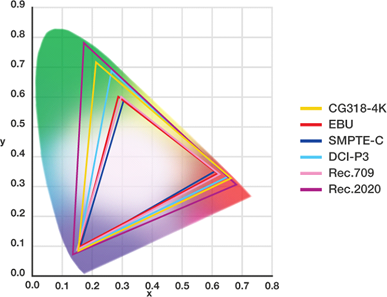
When we talk about a device’s gamut, what we are describing is the range of reproduceable colours supported by a device.
These gamut are defined by R, G and B values.
The YxZ-CIE Chromacity Diagram above shows the values for the gamuts most often associated with post-production. The horse shoe shape is called the spectral locus and represents the entire range of perceptible colour. © Eizo 2015
On the above diagram you can see different coloured triangles which represent different colour spaces or gamuts. If an RGB value were to fall outside of the gamut you are working in then it would be defined as “out of gamut” or simply an invalid signal. These types of errors are almost impossible to detect with the human eye but can cause problems when it comes to QC!

Waveform
Waveforms reflect your image from left to right and can be configured to show a specific colour channel or all 3. You can even use some waveforms to display only the luminance channel.
Normally the Y axis on a waveform will display 0 to 700mV or 0 to 100 IRE as this is the range of a legal broadcast signal peak to peak. If we are viewing 10 bit scopes then values on the Y axis may show 0 – 1023, or the full 10 bit range of the image. In both scenarios, 0 indicates black and
100/700/1023 indicates white.
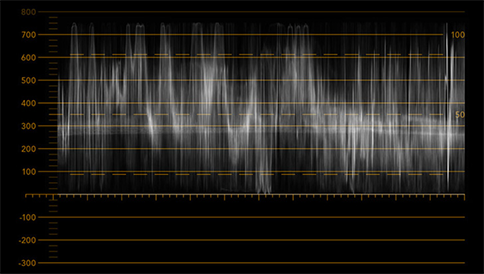
You can assess contrast through from a waveform by comparing the top and bottom points. Points further away from each other indicate there is a larger range between black and white meaning there is a greater contrast.
Parade
Much like a waveform, parades use the same X and Y axes however your channels, rather than being overlayed on top of each other, are split individually. This allows you to check for any errors within a specific channel. Detecting errors like colour casts can be very easy when using
a parade.
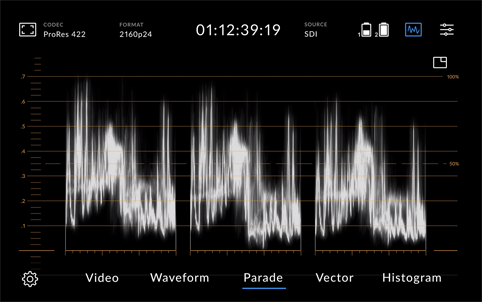
Waveform
Waveforms reflect your image from left to right and can be configured to show a specific colour channel or all 3. You can even use some waveforms to display only the luminance channel.
Normally the Y axis on a waveform will display 0 to 700mV or 0 to 100 IRE as this is the range of a legal broadcast signal peak to peak. If we are viewing 10 bit scopes then values on the Y axis may show 0 – 1023, or the full 10 bit range of the image. In both scenarios, 0 indicates black and
100/700/1023 indicates white.
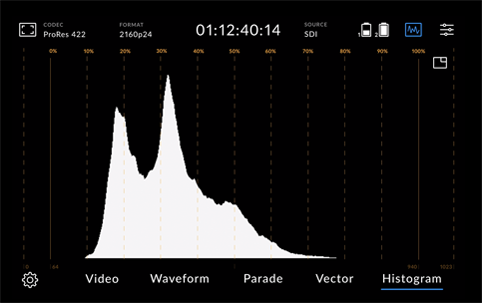
Evaluating the left, middle and right points of each graph allows the user to evaluate the color balance in the shadows, mids and highlights. These are often used on set to help camera people nail exposure.
Vectorscope
Vectorscopes are used to measure the saturation of hue values within a signal. These measurements are done by displaying a graph, originating from a centre point that is considered 0% saturation. If we think of a traditional colour wheel being around the edge of the graph, we can then understand how saturated a specific hue is by the point originating from the centre as the angle it extends at and the length of then extension define hue and saturation.
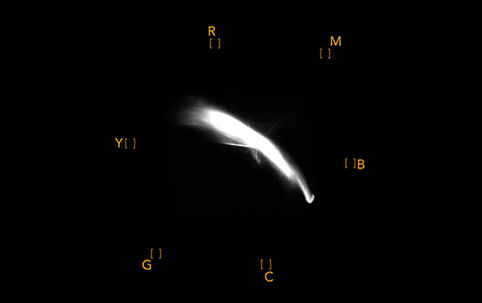
A good way to understand a vectorscope is to feed it with a colour bar test pattern. As most vectorscopes have 75% target boxes for Red, Magenta, Blue, Cyan, Green and Yellow hues a colour bar test pattern should show a graph that hits each of these targets.
Waveform
Devices that can output test patterns are invaluable. Being able to run a signal with precise measured values can help when lining up equipment and balancing images. A good example of this is colour bars. These aren’t just something that pops up on your TV after technical difficulties and are used every day in broadcast environments.A standard SMPTE colour bar pattern consists of different elements, each of which is designed to provide feedback on the signal itself. Different bars are used to check the intensity of specific colour values and that the black level sits at the correct IRE
The best test equipment
There you have it, everything you need to know when choosing a converter or scaler. We hope you've found this buyers guide helpful. Don't hesitate to contact one of our friendly advisors for more advice if you still have questions on how to select the perfect converter or scaler. If you’re all set to go we recommend checking out the converters and scalers from these top brands.
VIEW RANGE